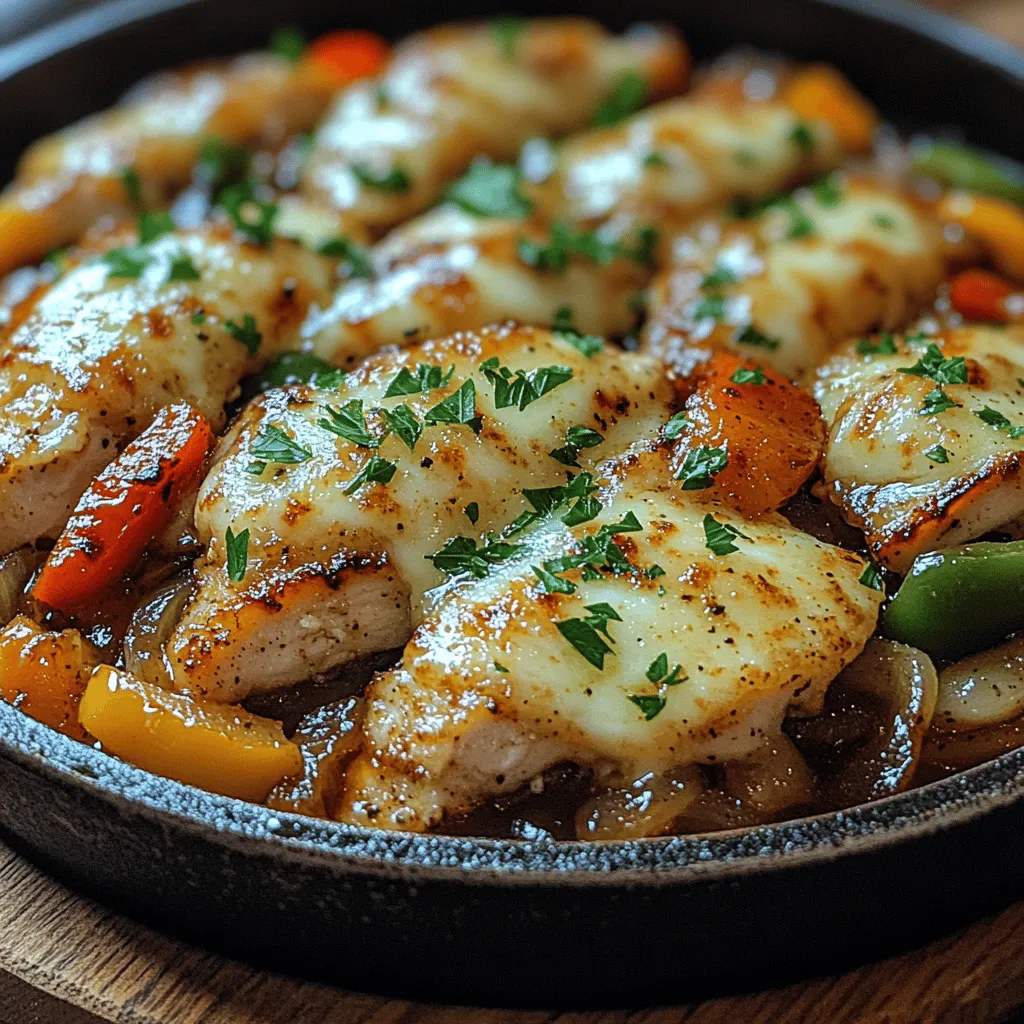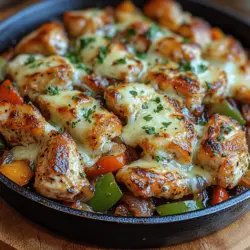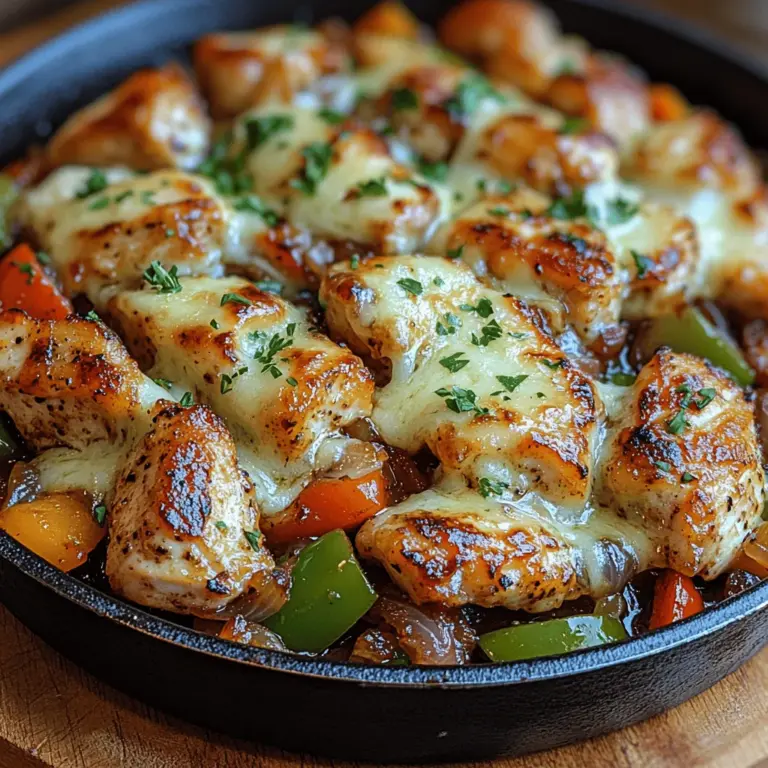Introduction: The Comfort of Chicken Cheesesteak Skillet
In the world of comfort food, few dishes evoke the same level of satisfaction as a classic cheesesteak. The combination of succulent meat, melted cheese, and vibrant vegetables wrapped up in a warm hoagie roll is undeniably enticing. However, for those who are looking for a quicker, healthier, and equally delicious alternative, the Chicken Cheesesteak Skillet is the perfect solution. This one-pan wonder captures the essence of a traditional cheesesteak, offering a delightful blend of juicy chicken, sautéed vegetables, and gooey melted cheese—all in a fraction of the time it takes to prepare the classic version.
This dish is ideal for busy weeknights when you’re craving something comforting but don’t have the luxury of hours to spend in the kitchen. Whether you’re cooking for your family or hosting casual gatherings with friends, the Chicken Cheesesteak Skillet is sure to please. In this article, we will delve into the ingredients that make this dish shine, provide step-by-step instructions to help you replicate it at home, and share some interesting insights about this mouthwatering recipe.
Understanding the Ingredients
The Role of Chicken in the Dish
At the heart of the Chicken Cheesesteak Skillet is the chicken itself. Chicken breasts are the lean protein base for this dish, providing a satisfying texture and flavor profile that pairs perfectly with the sautéed vegetables and melted cheese. Unlike traditional beef cheesesteaks, which can be rich and heavy, chicken offers a lighter alternative without sacrificing taste.
When cooked properly, chicken breasts can be incredibly juicy and tender. For this recipe, it’s essential to choose high-quality chicken breasts to ensure the best flavor. You can opt for boneless, skinless breasts to keep the preparation simple. If you’re feeling adventurous, you may even use chicken thighs for a slightly richer taste, though they will alter the dish’s overall character.
Exploring the Vegetables: Peppers and Onions
One of the standout features of the Chicken Cheesesteak Skillet is the vibrant mix of vegetables. The combination of green and red bell peppers, along with onions, not only adds a pop of color to the dish but also enhances its flavor profile.
Bell peppers are naturally sweet and, when sautéed, become tender and caramelized, bringing an incredible depth of flavor to the skillet. Green bell peppers contribute a slightly bitter note, while red bell peppers are sweeter, creating a balanced taste that complements the savory chicken and cheese. Onions, whether yellow or white, add a layer of sweetness and depth, making them a crucial ingredient in achieving that authentic cheesesteak flavor.
The Importance of Seasoning
No dish is complete without the right seasoning, and the Chicken Cheesesteak Skillet is no exception. A careful selection of spices can elevate the dish from ordinary to extraordinary. In this recipe, paprika and Italian seasoning play pivotal roles.
Paprika, with its smoky undertones, adds warmth and a subtle complexity to the dish. It works beautifully with the natural flavors of the chicken and vegetables, enhancing their taste without overpowering them. Italian seasoning, a blend of dried herbs like oregano, basil, and thyme, rounds out the flavor profile, providing a hint of Mediterranean flair that pairs well with the richness of the cheese.
The Creamy Element: Provolone Cheese
No cheesesteak would be complete without cheese, and for this recipe, provolone is the star. Known for its creamy melt and rich flavor, provolone cheese is a classic choice for cheesesteaks, delivering that gooey, indulgent texture we all crave.
When melted, provolone becomes wonderfully stretchy and smooth, enveloping the chicken and vegetables in a deliciously cheesy embrace. For those looking for a bit more flavor, you might consider mixing in some sharp cheddar or mozzarella for a unique twist. However, sticking with provolone will provide the most authentic cheesesteak experience.
Worcestershire Sauce and Chicken Broth: A Flavorful Duo
To further enhance the savory notes of the Chicken Cheesesteak Skillet, Worcestershire sauce and chicken broth are added to the mix. These ingredients serve to deepen the flavor and add moisture, ensuring that the dish remains juicy and flavorful.
Worcestershire sauce is a complex condiment made from fermented ingredients, which introduces umami and tanginess to the dish. It complements the savory chicken while balancing the sweetness of the vegetables. Chicken broth, on the other hand, provides the necessary liquid to keep the skillet moist and tender during cooking. Using low-sodium broth can help you control the saltiness of the dish while still adding great flavor.
Step-by-Step Instructions for Chicken Cheesesteak Skillet
Sautéing the Chicken to Perfection
The first step in achieving a delicious Chicken Cheesesteak Skillet is properly sautéing the chicken. Start by cutting the chicken breasts into thin, bite-sized strips. This method ensures even cooking and allows the chicken to absorb the flavors of the spices and vegetables effectively.
1. Heat the Oil: In a large skillet over medium-high heat, add a tablespoon of olive oil. Allow the oil to heat until it shimmers, indicating that it’s hot enough for cooking.
2. Season the Chicken: While the oil is heating, season the chicken strips with salt, pepper, paprika, and Italian seasoning. Toss the chicken to coat evenly, allowing the flavors to meld.
3. Cook the Chicken: Add the seasoned chicken to the skillet in a single layer. Avoid overcrowding the pan, as this can cause the chicken to steam rather than sauté. Cook for about 5-7 minutes, stirring occasionally, until the chicken is golden brown and cooked through. The internal temperature should reach 165°F (75°C) for safe consumption.
4. Remove and Set Aside: Once the chicken is cooked, remove it from the skillet and set it aside on a plate. This will allow the flavors to concentrate and prevent overcooking.
Cooking the Vegetables: Getting the Right Texture
With the chicken cooked to perfection, it’s time to focus on the vegetables. This step is crucial, as the texture and flavor of the sautéed peppers and onions can make or break the dish.
1. Add More Oil (if necessary): If the skillet seems dry, add another drizzle of olive oil. Let it heat for a moment before proceeding.
2. Sauté the Onions: Start by adding the sliced onions to the skillet. Cook them for about 2-3 minutes, stirring occasionally until they begin to soften and turn translucent. The goal is to release their natural sugars and create a sweet flavor base.
3. Add Bell Peppers: Once the onions are softened, add the sliced green and red bell peppers to the skillet. Sauté the mixture for an additional 5-7 minutes, stirring frequently. You want the peppers to become tender and slightly caramelized, which enhances their sweetness and overall flavor.
4. Season the Vegetables: As the vegetables cook, sprinkle a pinch of salt and pepper to enhance their natural flavors. You can also add a splash of Worcestershire sauce to infuse even more savory depth.
5. Combine: After the vegetables have reached the desired tenderness, return the cooked chicken to the skillet. Stir the mixture to combine and allow it to heat through for another minute or two.
This foundational step sets the stage for the final assembly of the Chicken Cheesesteak Skillet, where everything will come together to create a comforting, flavorful dish that will have your taste buds dancing with joy.

Combining Flavors for a Delicious Finish
To achieve the perfect Chicken Cheesesteak Skillet, it’s essential to meld the flavors of chicken, vegetables, and seasonings effectively. Begin by ensuring that your chicken is well-coated in the seasoning blend. The combination of garlic powder, onion powder, paprika, and salt will enhance the natural flavors of the chicken and complement the sweetness of the sautéed onions and bell peppers.
As the chicken cooks, the vegetables will release moisture, which will help create a savory base. Stirring occasionally allows the ingredients to intermingle, enhancing the overall flavor profile. Once the chicken is cooked through and the vegetables are tender, consider adding a splash of Worcestershire sauce or a hint of soy sauce. This will add depth and a subtle umami flavor that ties all the elements together seamlessly.
Melting the Cheese: Tips for the Perfect Melt
One of the hallmarks of a great cheesesteak is that glorious, gooey cheese layer that blankets the chicken and vegetables. To achieve this in your skillet, you’ll want to use a cheese that melts beautifully. Provolone, mozzarella, or even Cheez Whiz are traditional choices, but feel free to experiment with your favorites.
To melt the cheese perfectly without overcooking the chicken, follow these steps:
1. Lower the Heat: After the chicken and vegetables are fully cooked, reduce the heat to low. This will prevent the chicken from continuing to cook while you melt the cheese.
2. Add Cheese Generously: Evenly distribute your chosen cheese over the chicken and vegetable mixture in the skillet. Use enough cheese to create a generous layer, as this contributes to the overall flavor and texture.
3. Cover the Skillet: Place a lid over the skillet. This traps heat and moisture, allowing the cheese to melt evenly and thoroughly.
4. Check for Doneness: After a few minutes, check the cheese to see if it has melted to your liking. The goal is a creamy, melty top that binds the dish together without losing the chicken’s juiciness.
5. Optional Browning: For an extra layer of flavor, consider placing the skillet under a broiler for a minute or two. Just be sure to watch it closely to avoid burning.
Serving Suggestions: Hoagie Rolls or Crusty Buns
When it comes to serving your Chicken Cheesesteak Skillet, there are several delicious options to consider. While some may prefer the traditional hoagie rolls, others might enjoy crusty buns or even a lighter option like lettuce wraps for a low-carb meal.
1. Hoagie Rolls: Slice hoagie rolls lengthwise and lightly toast them. Fill each roll generously with the chicken and cheese mixture, allowing the warm filling to seep into the bread. Top with fresh toppings like sliced jalapeños, pickles, or even a drizzle of ranch dressing for added zest.
2. Crusty Buns: For a heartier option, serve the dish in crusty artisan buns. The crunch of the bread contrasts beautifully with the soft, melty filling. A smear of butter or garlic spread on the buns before toasting can elevate the flavor further.
3. Accompaniments: Pair your Chicken Cheesesteak Skillet with a side of crispy fries or a fresh salad. A tangy coleslaw can provide a refreshing crunch, balancing the richness of the cheesesteak.
4. Garnishes: Consider garnishing with fresh herbs like chopped parsley or cilantro for a pop of color and freshness. A sprinkle of crushed red pepper can add a hint of heat for those who enjoy a spicy kick.
Nutrition and Health Benefits of the Chicken Cheesesteak Skillet
Analyzing the Nutritional Value
The Chicken Cheesesteak Skillet is not only delicious but also offers a balanced nutritional profile. A typical serving contains approximately:
– Calories: 350-400 calories, depending on the amount of cheese and any additional toppings.
– Protein: Around 30-35 grams, primarily from the chicken and cheese, making it a great source of lean protein.
– Fats: Approximately 15-20 grams, with healthy fats coming from the cheese and any cooking oil used.
– Carbohydrates: Roughly 30-35 grams, mainly from the hoagie rolls or buns if used; this can be adjusted if opting for a low-carb serving.
Healthier Alternatives to Traditional Cheesesteaks
This Chicken Cheesesteak Skillet provides a lighter alternative to traditional cheesesteak sandwiches without sacrificing flavor. Here are some ways to make it even healthier:
1. Lean Protein: Using chicken breast or turkey instead of beef reduces saturated fat and increases your overall lean protein intake.
2. Vegetable Boost: Adding more vegetables, such as mushrooms, zucchini, or spinach, increases the fiber content and nutritional value, making the dish more filling without adding many calories.
3. Cheese Choices: Opt for lower-fat cheese options or use less cheese than traditional recipes call for. This can significantly cut down the calorie count while still providing that beloved cheesy flavor.
4. Bread Alternatives: For a truly health-conscious approach, consider serving the chicken and cheese mixture in lettuce wraps or over a bed of quinoa or brown rice. This maintains the integrity of the flavors while offering a gluten-free or lower-carb option.
Cultural Significance of the Cheesesteak
The Origins of the Cheesesteak
The cheesesteak sandwich has an iconic status, particularly in Philadelphia, where it originated in the early 20th century. The story goes that in the 1930s, a hot dog vendor named Pat Olivieri decided to grill some beef on his cart for lunch. The aroma attracted passersby, and before long, he was creating a sensation that would become the beloved cheesesteak.
Over the years, the sandwich evolved, with melted cheese added to the mix, creating what we now know as the classic cheesesteak. Today, Philadelphia is home to numerous cheesesteak joints, each boasting its own take on the classic preparation, solidifying its place in American culinary culture.
Modern Variations of the Classic Cheesesteak
As food culture evolves, so does the cheesesteak. Various regions have put their own twist on this classic sandwich, leading to a diverse array of options. The Chicken Cheesesteak is one such variation that has gained popularity, particularly among those looking for a lighter alternative.
In addition to chicken, you might find regional specialties that include different proteins like pork or even vegetarian alternatives made from mushrooms or plant-based meats. Toppings have also expanded beyond the traditional sautéed onions and cheese, with options like roasted peppers, jalapeños, and gourmet sauces becoming commonplace.
Conclusion: Enjoying Your Chicken Cheesesteak Skillet
The Chicken Cheesesteak Skillet is more than just a meal; it’s a celebration of flavors and textures that brings comfort to any dining table. With its easy preparation and delightful taste, this dish is destined to become a favorite in your culinary repertoire. Whether you serve it in hoagie rolls or enjoy it straight from the skillet, this recipe encapsulates the essence of a beloved classic while offering a modern twist that everyone can enjoy.
Every bite of this Chicken Cheesesteak Skillet is a reminder of the joy that comes from cooking and sharing good food. So gather your ingredients, follow these steps, and embrace the comfort that this quick and satisfying meal brings to your table. Happy cooking!

